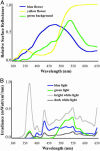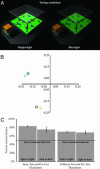Seeing the light: illumination as a contextual cue to color choice behavior in bumblebees
- PMID: 15731346
- PMCID: PMC553337
- DOI: 10.1073/pnas.0500681102
Seeing the light: illumination as a contextual cue to color choice behavior in bumblebees
Abstract
The principal challenge faced by any color vision system is to contend with the inherent ambiguity of stimulus information, which represents the interaction between multiple attributes of the world (e.g., object reflectance and illumination). How natural systems deal with this problem is not known, although traditional hypotheses are predicated on the idea that vision represents object reflectance accurately by discounting early in processing the conflating effects of illumination. Here, we test the merits of this general supposition by confronting bumblebees (Bombus terrestris) with a color discrimination task that can be solved only if information about the illuminant is not discounted but maintained in processing and thus available to higher-order learned behavior. We show that bees correctly use the intensity and chromaticity of illumination as a contextual cue to guide them to different target colors. In fact, we trained bees to choose opposite, rather than most similar, target colors after an illumination change. This performance cannot be explained with a simple color-constancy mechanism that discounts illumination. Further tests show that bees do not use a simple assessment of the overhead illumination, but that they assess the spectral relationships between a floral target and its background. These results demonstrate that bees can be color-constant without discounting the illuminant; that, in fact, they can use information about the illuminant itself as a salient source of information.
Figures




Similar articles
-
Biological significance of distinguishing between similar colours in spectrally variable illumination: bumblebees (Bombus terrestris) as a case study.J Comp Physiol A Neuroethol Sens Neural Behav Physiol. 2004 Feb;190(2):105-14. doi: 10.1007/s00359-003-0475-2. Epub 2003 Dec 3. J Comp Physiol A Neuroethol Sens Neural Behav Physiol. 2004. PMID: 14652688
-
The biological significance of color constancy: an agent-based model with bees foraging from flowers under varied illumination.J Vis. 2013 Aug 20;13(10):10. doi: 10.1167/13.10.10. J Vis. 2013. PMID: 23962735
-
Bees encode behaviorally significant spectral relationships in complex scenes to resolve stimulus ambiguity.Proc Natl Acad Sci U S A. 2005 Nov 15;102(46):16870-4. doi: 10.1073/pnas.0503773102. Epub 2005 Nov 4. Proc Natl Acad Sci U S A. 2005. PMID: 16272222 Free PMC article.
-
Lightness, illumination, and gradients.Spat Vis. 2006;19(2-4):219-61. doi: 10.1163/156856806776923407. Spat Vis. 2006. PMID: 16862841 Review.
-
Color and polarization vision in foraging Papilio.J Comp Physiol A Neuroethol Sens Neural Behav Physiol. 2014 Jun;200(6):513-26. doi: 10.1007/s00359-014-0903-5. Epub 2014 Apr 11. J Comp Physiol A Neuroethol Sens Neural Behav Physiol. 2014. PMID: 24722674 Review.
Cited by
-
Color of Pan Trap Influences Sampling of Bees in Livestock Pasture Ecosystem.Biology (Basel). 2021 May 19;10(5):445. doi: 10.3390/biology10050445. Biology (Basel). 2021. PMID: 34069447 Free PMC article.
-
Why background colour matters to bees and flowers.J Comp Physiol A Neuroethol Sens Neural Behav Physiol. 2017 May;203(5):369-380. doi: 10.1007/s00359-017-1175-7. Epub 2017 May 6. J Comp Physiol A Neuroethol Sens Neural Behav Physiol. 2017. PMID: 28478535
-
Learned Use of Picture Cues by Bumblebees (Bombus impatiens) in a Delayed Matching Task.Behav Sci (Basel). 2016 Oct 14;6(4):22. doi: 10.3390/bs6040022. Behav Sci (Basel). 2016. PMID: 27754410 Free PMC article.
-
Bumblebees directly perceive variations in the spectral quality of illumination.J Comp Physiol A Neuroethol Sens Neural Behav Physiol. 2006 Mar;192(3):333-8. doi: 10.1007/s00359-005-0088-z. Epub 2006 Jan 11. J Comp Physiol A Neuroethol Sens Neural Behav Physiol. 2006. PMID: 16404603
-
Colour constancy in insects.J Comp Physiol A Neuroethol Sens Neural Behav Physiol. 2014 Jun;200(6):435-48. doi: 10.1007/s00359-014-0897-z. Epub 2014 Mar 20. J Comp Physiol A Neuroethol Sens Neural Behav Physiol. 2014. PMID: 24647930
References
Publication types
MeSH terms
Grants and funding
LinkOut - more resources
Full Text Sources

